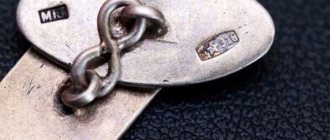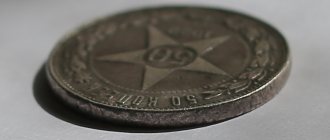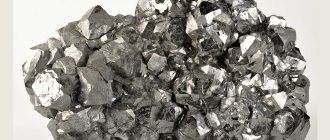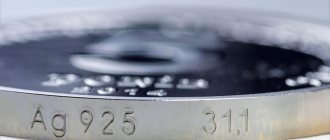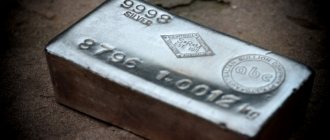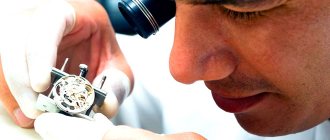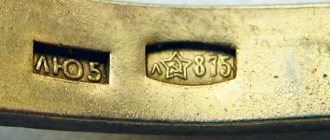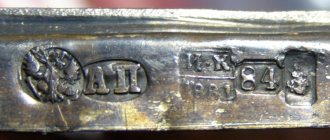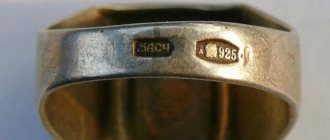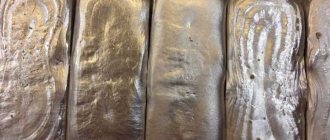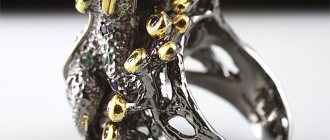What is a sample and why is it needed?
Silver is a soft material that cannot be used to make jewelry. For this, alloys are used, and copper is added to silver. The finished alloy is strong, malleable and resistant to corrosion. In addition to copper, the following alloys are often added to the alloy: zinc, aluminum, cadmium, antimony, palladium, lead, iron, nickel, bismuth. Depending on the composition of the product, its characteristics, shade and cost change.
Fineness is a three-digit number that indicates the percentage of pure metal that is in the alloy. For example, 925 sterling silver accessories are 92.5% pure silver. The sample is necessary so that a person can determine whether the jewelry in front of him is real or a fake. If there is no stamp, it is most likely a fake jewelry or the sample has worn off due to prolonged wear of the accessory.
You can find products that contain 84 samples. Theoretically, it cannot contain 84 grams of silver and 916 grams of impurities. The value is simply indicated in a different measurement system. Until 1927, samples were determined using spools. If we convert this value to the metric system, the number will correspond to 875. In addition to the spool test, in ancient times the ratio of silver in products was measured using the lot and carat systems. Special tables have been developed where the generally accepted sample is converted into various values.
Silver markings on jewelry
The sample is indicated not only on paper tags that are sold along with jewelry. Marking is also required on the accessories themselves, so that you can see what percentage of metal they contain. The sample number is placed in different places:
- on a clasp or earrings;
- in the inner part;
- closer to the clasp.
If the product is very thin, then the sample is stamped on a small molten plate. On cookware, markings are placed on the back of the handle.
If there is no marking, this is a fake that contains no metal. Most often, unmarked products are made of medical or stainless steel. If your accessory is made in Russia, in addition to the sample number, there will be a small stamp on the jewelry.
How to distinguish silver from fake
Contrary to popular belief, price is not always an indicator of quality. Real silver is not as expensive as many people think. So, a simple ring can be bought for only 1000 rubles.
Silver rings (go to the SUNLIGHT catalog)
First, you need to know how silver looks and behaves in its pure form. If your silver ring suddenly becomes very bent, do not rush to consider it a fake - in its pure form it is a very soft metal. Finding a hallmark will help you find out whether you were given a silver ring, as well as determine whether or not you got a silver spoon from your grandmother.
Silver products sold on the world market must be marked with a hallmark - three numbers. According to international standards, silver must be marked with the numbers 925, 900 or 800. 925 hallmark indicates that the product contains 92.5% silver, and 900 and 800 hallmarks indicate that 90% or 80% precious metal.
If there is no mark on your product, do not rush to get upset - it is quite possible that your jewelry was simply not created for sale. What other ways can you recognize silver at home? Let's figure it out.
Iodine
Identify silver using iodine
It is very easy to test silver at home using iodine. The main thing here is to be careful, since too much iodine can ruin the item.
So, how to distinguish fake from real silver using iodine? Dip a cotton swab in iodine, run it over the metal and quickly wash off the applied composition. If the jewelry is really made of silver, iodine will leave a dull gray stain on it - the darker it is, the higher the standard. Don't be afraid to ruin the item - if you wash off the composition quickly enough, the stain will soon disappear. If this is a fake, after checking it will have a white limescale residue on it.
Magnet
Since real silver is not magnetic, this test will take you less than five seconds. Take any souvenir from the refrigerator and bring it to the decoration. If a magnet attracts it, this is a fake. If the jewelry remains in place, you can be sure that it is real silver.
Vinegar
While at home, you can test your silver with vinegar. The instructions for such a check are quite simple:
- Lightly scratch the product with a needle and drop vinegar onto the scratch;
- If the scratch is covered with greenish foam, this is a fake;
- If there is no foam, and the scratch is covered with a white substance, it is real silver.
lapis pencil
Testing silver with a lapis pencil is one of the most reliable methods of checking at home. You can buy it at any pharmacy. To check, put on gloves and run a pencil over the jewelry. If after this a black stripe appears, the silver is fake.
Thermal conductivity
Silver has excellent thermal conductivity, so heating the jewelry can also serve as a verification of authenticity.
Dip the item in warm water or squeeze it between your palms to warm it up. After a few minutes, try placing an ice cube on it. If the ice begins to melt from the heat of the metal, it means that this is real silver.
Chalk
Recognize silver using chalk
Ordinary chalk will also help you recognize silver at home. Having almost the same properties as iodine, chalk can serve as an excellent assistant in safely testing silver for authenticity. Wipe the surface of the item being tested with chalk - if a black mark appears on it, it means the item is real.
